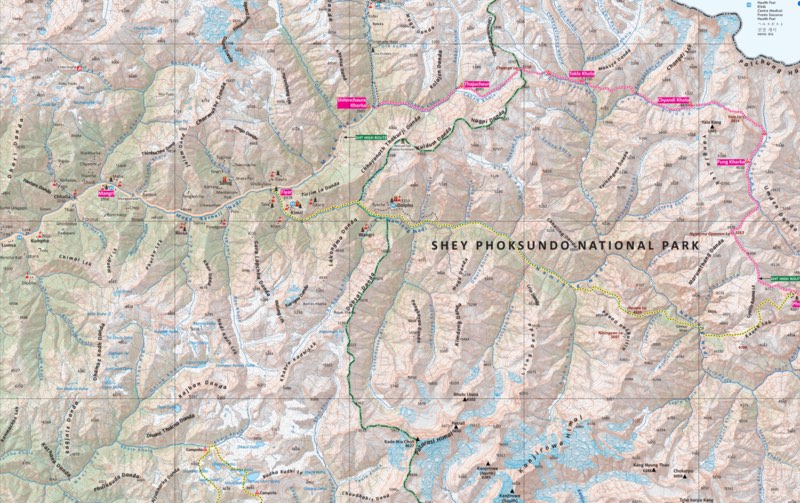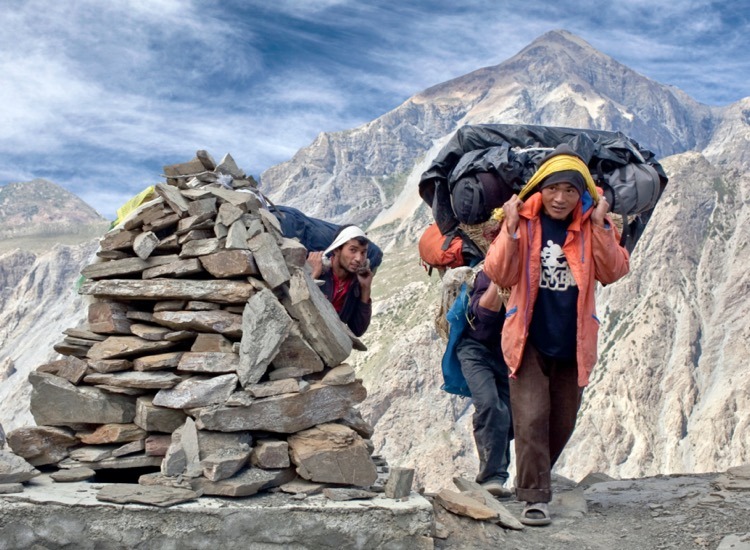Dolpo Rara Traverse Trek
Request a Quote (?)
- Satisfied Client
- Personalised Guide
- Instant Response
Get Instant Response:
+977-9851329446 (Whatsapp)
| Starts at: Jhupal | Ends at: Talcha |
| Trek Region: Dolpo & Mugu | Transport: Flight |
| Duration: 22 Days | Trip Grade: Challenging |
| Max Altitude: 5490 m / 18011 ft | Accommodation: Camping |
Dolpo Rara Traverse Trek Highlights
- One of the biggest lakes of Nepal, Rara Lake
- Enjoy the soft breezes of Shey Phoksundo lake, the deepest oligotrophic lake in Nepal
- Collect blessings at Shey Gompa, a 12th century monastery in DolpoBecome an active participant of Bon dance and other cultural activities
- Explore around the Rara National Park, and explore the diverse flora and fauna of the region
The Upper Dolpo to Rara Traverse trek highlights two of the most beautiful high altitude lakes in Nepal. Starting in the barren yet stunningly beautiful landscape of Dolpo, and ending in the equally beautiful Mugu district, one of the poorest areas of the country, this trek is as challenging as it is enthralling. Spread over three weeks, there are four high passes to cross as well as high, steep, narrow and rocky trails to negotiate. A good deal of this trek is done at over 4,000m with the passes being between 5,000 to 5,500m. The lakes themselves Phoksundo (3,641m) in Dolpo and Rara (2,980m) in Mugu are both turquoise jewels set in a craggy, rocky landscape, and in pine forests, respectively. On the way the route, part of the newly opened east to west Great Himalayan Trail (GHT), passes through interesting villages with a Buddhist culture closely linked to Tibet, monasteries and gompa, and the quartz studded Crystal Mountain.
Dolpo is an area where the Bon Po religion (similar but different to Tibetan Buddhism) is still practiced and the majority of the people are more closely tied to Tibet than Nepal. Trade routes along which yaks and mules pass still run from Tibet to the lower parts of Nepal. Shey Gompa, a 12th century monastery, is often referred to as the spiritual heart of Dolpo, and is situated at the base of the Crystal Mountain, a long-standing pilgrimage area.
Mugu is the least developed district of Nepal, where its rugged landscape has meant it remains pretty much as it was in the past. With the opening of the GHT and a push towards local tourism, the beautiful Rara Lake, Nepal’s largest, is making its way onto the map. Rara National Park is the smallest national park in Nepal at only 106 square kilometers. As in the Shey Phoksundo National Park (3,55km2) which covers a large portion of Dolpo, there are several interesting mammal species in Rara National Park including the snow leopard, red panda, Himalayan black bear, musk deer, Langur and rhesus monkeys, among others.
Stark landscapes, alpine forests, green meadows, craggy rock faces, tricky trails, high passes, beautiful people and completely stunning lakes await those with the time and willingness to try out this section of the Great Himalayan Trail.
Dolpo Rara Traverse Trek Itinerary
Day 1: Kathmandu to Nepalgunj (Flight)
Nepalgunj – 150 m / 492 ft – 50 minutes
Day 2: Nepalgunj to Jhupal (Flight) to Chhepak
Chhepak – 2830 m / 9284 ft – 6 hrs
Day 3: Chhepak to Chunuwar
Chunuwar – 3130 m / 10269 ft – 6 hrs
Day 4: Chunuwar to Ringmo
Ringmo – 3612 m / 11850 ft – 4 hrs
Day 5: Acclimatization Day
Ringmo – 3612 m / 11850 ft – 2 hrs
Day 6: Ringmo to Chunemba
Chunemba – 3639 m / 11938 ft – 5 hrs
Day 7: Chunemba to Snowfield Camp
Snowfield Camp – 4400 m / 14435 ft – 7 hrs
Day 8: Snowfield Camp to Shey Gompa
Shey Gompa – 4310 m / 14140 ft – 6 hrs
Day 9: Shey Gompa to Bhijer
Bhijer – 3850 m / 12631 ft – 6 hrs
Day 10: Bhijer to Pho
Pho – 4087 m / 13408 ft – 8 hrs
Day 11: Pho to Pung Kharka
Pung Kharka – 4650 m / 15255 ft – 7 hrs
Day 12: Pung Kharka to Chyandi Khola
Chyandi Khola – 4830 m / 15846 ft – 6 hrs
Day 13: Chyandi Khola to Takla Khola
Takla Khola – 3785 m / 12417 ft – 7 hrs
Day 14: Takla Khola to Thaju Chaur
Thaju Chaur – 4050 m / 13287 ft – 7 hrs
Day 15: Thaju Chaur to Shilen Chaur Kharka
Shilen Chaur Kharka – 2945 m / 9662 ft – 6 hrs
Day 16: Shilen Chaur Kharka to Tiyar
Tiyar – 2418 m / 7933 ft – 4 hrs
Day 17: Tiyar to Mangri
Mangri – 1950 / 6397 ft – 4 hrs
Day 18: Mangri to Gamgadi
Gamgadi – 2095 m / 6873 ft – 4 hrs
Day 19: Gamgadi to Rara Lake
Rara Lake – 2980 m / 9776 ft – 4 hrs
Day 20: Day Trip To View Point
Rara Lake – 2980 m / 9776 ft – 4 hrs
Day 21: Rara Lake to Talcha
Talcha – 2990 m / 9809 ft – 3 hrs
Day 22: Talcha to Nepalgunj (Flight) to Kathmandu (Flight)
Kathmandu – 1300 m / 4265 ft – 2 hrs
Not satisfied with this Itinerary?
Are you interested on planning custom trip? It only takes 2 minutes.
Includes
- 21 nights accommodation in mountain teahouses and tents
- 1 night accommodation in Nepalgunj (Hotel Sneha or similar)
- Guide for 22 days
- Cook for 22 days
- Required number of porters for 22 days
- Kathmandu Nepalgunj, Nepalgunj Jhupal flight
- Jhupal Nepalgunj, Nepalgunj Kathmandu flight
- Shey Phoksundo national park and Rara national park permits
- Restricted area permit
- 22 x breakfast, 21 x lunch and 21 x dinner while on the trek
- Lunch and dinner in Nepalgunj
Dolpo Rara Traverse Trek Map

Related Trip in Dolpo Region
Lower Dolpo Circuit Trek | Upper Dolpo to Upper Mustang | Upper Dolpo Circuit Trek | Putha Hiunchuli Expedition
